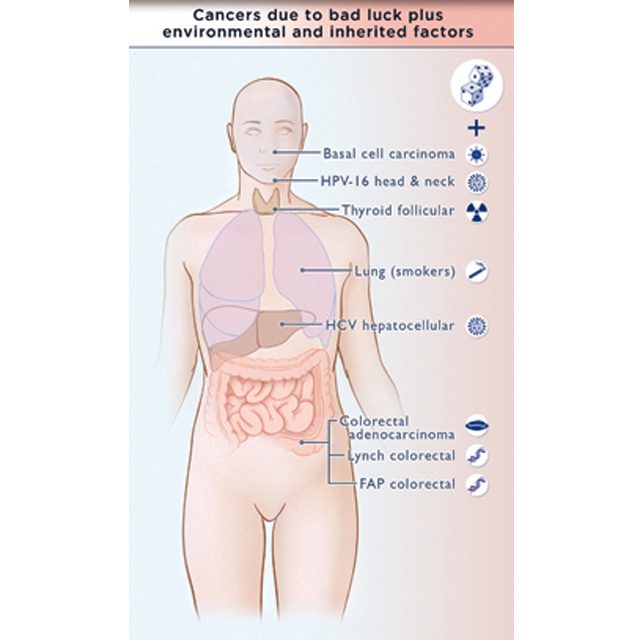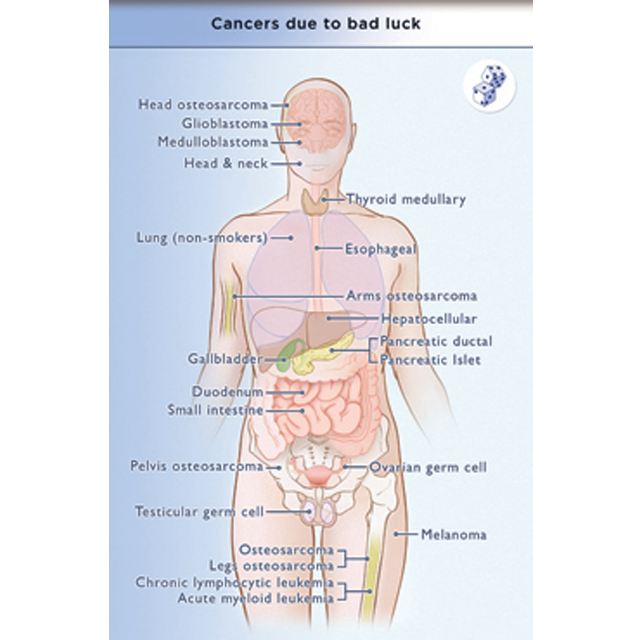Ammalarsi di tumore e’ solo questione di fortuna ?
Ecco come gli Autori sono arrivati a questa conclusione. Prendete il numero di cellule in un organo, individuate quante di queste cellule sono cellule staminali a lunga vita, e determinate quante volte le cellule staminali si sono divise. Con ogni divisione aumenta il rischio di una mutazione che causa il cancro in una cellula figlia. Così, Tomasetti e Vogelstein arrivano alla conclusione che i i tessuti che contengono cellule con il maggior numero di divisioni cellulari staminali sono quelli più vulnerabili al cancro.
Dopo aver studiato i dati della letteratura riferiti a 31 tipi di tumori gli Autori concludono che due terzi sarebbero dovuti a mutazioni casuali.
”Tutti i tumori sono causati da una combinazione di sfortuna, ambiente e ereditarietà – spiega Bert Volgenstein, uno degli autori – e noi abbiamo creato un modello matematico che può quantificare ogni contributo”.
In 22 casi, spiegano gli autori, che vanno dal cancro del duodeno a diversi tumori del distretto testa-collo, le mutazioni casuali hanno un peso preponderante, mentre negli altri nove, fra cui polmoni, fegato e tiroide, sono i fattori ambientali e familiari a decidere, anche se sempre combinati con la ‘sfortuna’. ”I rari casi di fumatori che non sviluppano tumori sono spesso attribuiti a ‘buoni geni’ – continua l’autore -, ma la verità è che sono invece solo fortunati. I cambiamenti di stili di vita possono avere un grandissimo impatto su alcuni tipi di tumori, ma secondo i nostri risultati su altri non hanno influenza. In questo caso il modo migliore per combatterli è la diagnosi precoce, quando ancora si può intervenire con la chirurgia”
Attenzione a non attenuare la prevenzione continuando ad aderire ad un corretto stile di vita ( attivita’ fisica adeguata, alimentazione corretta , abolizione del fumo etc..), che oltre che per i tumori e’ fondamentale per prevenire le malattie cardiovascolari ed altri disturbi.
Science 2 January 2015:
Vol. 347 no. 6217 pp. 78-81
DOI: 10.1126/science.1260825
REPORT
Variation in cancer risk among tissues can be explained by the number of stem cell divisions
Cristian Tomasetti 1,Bert Vogelstein 2
–
1 Division of Biostatistics and Bioinformatics, Department of Oncology, Sidney Kimmel Cancer Center, Johns Hopkins University School of Medicine and Department of Biostatistics, Johns Hopkins Bloomberg School of Public Health, 550 North Broadway, Baltimore, MD 21205, USA.
2 Ludwig Center for Cancer Genetics and Therapeutics and Howard Hughes Medical Institute, Johns Hopkins Kimmel Cancer Center, 1650 Orleans Street, Baltimore, MD 21205, USA.
↵*Corresponding author. E-mail: [email protected] (C.T.); [email protected] (B.V.)
ABSTRACT
Some tissue types give rise to human cancers millions of times more often than other tissue types. Although this has been recognized for more than a century, it has never been explained. Here, we show that the lifetime risk of cancers of many different types is strongly correlated (0.81) with the total number of divisions of the normal self-renewing cells maintaining that tissue’s homeostasis. These results suggest that only a third of the variation in cancer risk among tissues is attributable to environmental factors or inherited predispositions. The majority is due to “bad luck,” that is, random mutations arising during DNA replication in normal, noncancerous stem cells. This is important not only for understanding the disease but also for designing strategies to limit the mortality it causes.






